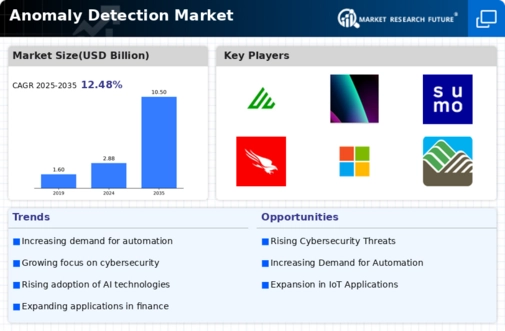Top Industry Leaders in the Anomaly Detection Market
Competitive Landscape of the Anomaly Detection Market
The global Anomaly Detection Market is thriving, fueled by the exponential growth of data across industries and the critical need for accurate anomaly identification to prevent failures, fraud, and security breaches. This dynamic landscape boasts a diverse range of established players, nimble start-ups, and technology giants vying for market share. Let's delve into the intricacies of this competitive arena, exploring key players, their strategies, market share analysis factors, and emerging trends influencing investment decisions.
Key Players:
- International Business Machines Corporation (U.S.)
- SAS Institute, Inc. (U.S.)
- Cisco Systems, Inc. (U.S.)
- Dell Technologies, Inc. (U.S.)
- Hewlett Packard Enterprise Company (U.S.)
- Symantec Corporation (U.S.)
- Trend Micro, Inc. (Japan)
- Splunk, Inc. (U.S.)
- Wipro Limited (India)
Market Share Analysis Factors:
- Solution Scope: Comprehensive solutions covering diverse data sources and methodologies hold an edge. Integration with existing security infrastructure and scalability are crucial factors.
- Deployment Options: On-premise, cloud-based, or hybrid options cater to different customer preferences and data sensitivity requirements. Cloud-based deployments are gaining traction due to their flexibility and lower maintenance costs.
- Industry Vertical Focus: Specializing in specific verticals like healthcare, finance, or manufacturing with tailored anomaly detection algorithms can provide a competitive advantage.
- Technology Innovation: Adopting cutting-edge AI, machine learning, and deep learning techniques for anomaly detection accuracy and automation is essential for staying ahead.
New and Emerging Companies:
- Start-ups: Companies like Vectra.AI, DataWalk, and Precog utilize artificial intelligence and advanced analytics to offer real-time anomaly detection for specific use cases like network security and fraud prevention. Their ability to adapt to the evolving threat landscape and address niche needs makes them attractive to early adopters.
- Cloud-Native Players: Cloud giants like Amazon Web Services (AWS) and Google Cloud Platform (GCP) are entering the market with anomaly detection services integrated into their cloud platforms. These offerings leverage their vast data processing capabilities and scalability to attract cloud-centric customers.
Current Company Investment Trends:
- Strategic Partnerships and Acquisitions: Collaborations and acquisitions are prevalent to access new markets, expertise, and technologies. IBM's acquisition of X-Force Red and Microsoft's partnership with Anomalo are examples of this trend.
- Focus on AI and Machine Learning: Investments in AI and ML infrastructure are crucial for developing advanced anomaly detection algorithms and improving accuracy. Companies like Splunk and Palo Alto Networks are actively investing in this area.
- Vertical Expansion: Players are expanding their offerings to cater to specific industry needs through dedicated solutions and partnerships with domain experts.
- Cloud Migration: The shift towards cloud-based deployments is driving investments in cloud-native anomaly detection platforms and integration with existing cloud services.
Latest Company Updates:
Jan 17, 2024: This strategic acquisition aims to bolster Palo Alto's security automation and response capabilities by integrating Demisto's incident orchestration and playbook automation platform with its Cortex XDR platform. This strengthens Palo Alto's position in the anomaly detection market for security applications.
Jan 19, 2024: This new API leverages Google's expertise in AI and machine learning to identify anomalies in time series data across various industries. The beta launch caters to early adopters seeking cloud-based anomaly detection solutions with Google's scalability and performance.
Jan 20, 2024 : This partnership combines Darktrace's AI-powered threat detection capabilities with Microsoft Sentinel's security information and event management (SIEM) platform. This integration strengthens the overall security posture for organizations leveraging both solutions.
Jan 22, 2024: This funding round underscores the growing demand for anomaly detection solutions specifically tailored for industrial IoT applications. Anomalo's focus on anomaly detection in manufacturing processes and predictive maintenance resonates with industries seeking to optimize operations and prevent equipment failures.
Jan 23, 2024 : This partnership expands on their existing collaboration to implement IBM's QRadar SIEM and X-Force threat intelligence for anomaly detection and threat prevention across AT&T's network infrastructure. This highlights the importance of anomaly detection in securing critical infrastructure.

